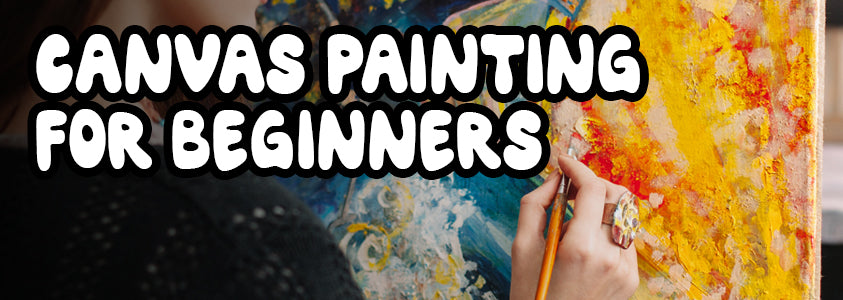Canvas painting can feel daunting for newer artists that are used to creating their pieces exclusively on paper, but it really shouldn't be. There are distinct pros and cons of canvas. You'll also want to learn about the different types of canvas and proper preparation. I promise it's a lot more simple than it sounds and it is absolutely worth learning all the gritty details.
Canvas is longer lasting and more durable than paper which means you can look back on how far you've come each year. My first canvas painting is horrible but I still have it hidden away so that I can first stare in abject terror, and then pat myself on the back for improving. So, how can you choose your first canvas? Lets discuss!

Pros and Cons of Canvas Painting
As stated, the most obvious reason to paint on canvas for anyone including beginners is to preserve their work for extended periods. Paired with that durability is the fact that canvas is lightweight and extremely easy to transport. You can certainly paint on a long-lasting surface such as wood or stone but they will never provide the portability of a simple canvas surface.
Canvas isn't without its flaws, particularly if the surface in question hasn't been properly treated. Canvas can flex quite a bit depending on the amount of moisture in the air. The temperature is also a big factor in cracking. A very humid environment will create expansion which can lead to cracks in some of those works that you've painstakingly created. It can be a real heart breaking moment.
Luckily, picking the right canvas and treating it can alleviate this issue.

Picking the Right Beginner Canvas
Canvas and paper are know as 'supports'. Which artist's support is right for you? Well, a stretched canvas can run anywhere from about a dollar each to almost $40 depending on the size and quality of materials used, so which surface is right for you? Are those pricey canvases really worth shelling out for? It's my belief that a beginner to canvas painting should go cheap to allow experimentation without breaking the bank.
The most common materials are linen and cotton. Cotton is much more forgiving on your wallet and I personally enjoy the less structured feeling that stretched cotton offers. Linen canvas often has a grid pattern on its surface which can be quite noticeable. Depending on the look you're attempting one material might serve better than another, but overall my art and my pocketbook prefer linen.
I will say however that if you're at the point where you've been commissioned you should be ready to invest in linen canvas. The buyer will definitely appreciate that you've used the highest quality materials possible.

Picking Your Primer
Similar to the dichotomy presents in linen vs. cotton, picking a primer for your canvas can be simplified into porous vs. non-porous. You will need to pick a primer for your canvas before starting to work (unless it's had primer pre-applied of course).
An acrylic gesso primer will create a porous surface. Porous surfaces absorb the paint quicker and are less workable. A porous canvas work will dry shockingly fast which can be good or bad depending on how workable you require the paint to be.
Oil primers create a non-porous surface which means that no moisture will be absorbed. Your work will only dry through natural evaporation. This can be bad if you need to move a painting right after completion, but it's nice to have the paints remain wet enough to be workable after you've stepped away for lunch.

Oil or Acrylic?
The final dilemma you will encounter once your beginner's canvas has been picked and primed is whether to use oil or acrylic as the medium to create the work of art that your brain has laid out. I'd recommend acrylic paint set to start, it is versatile and relatively easy to use. You can use acrylic paint straight out of the tube, or water it down for a different look similar to water color.
Oil is a fickle mistress and I don't hesitate to say that I'm nowhere near getting a grasp on quality oil painting. You might like to look up some oil painting tips to help you along, but be warned that it's going to take a lot of practice to create something truly stunning. Regardless of which medium you choose, you can still create something amazing if given the problem time, effort, and vision.
Final Thoughts
I hope that breaking the decision down into three distinct choices has made the starting steps into painting on canvas easy for beginners. It's never easy to make the leap from pen to brush, particularly in an age when digital media has proliferated in every facet of our existence... But there is certainly something to be said for working with your hands and creating a tangible work of art. I wish you the best of luck in your own endeavors!




